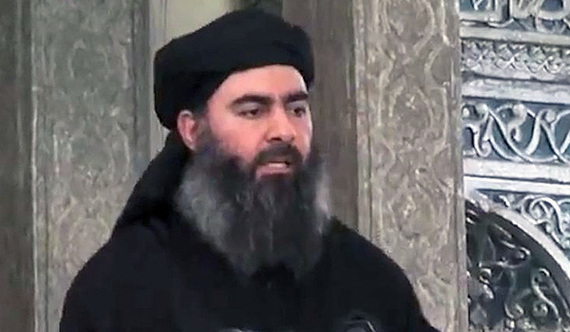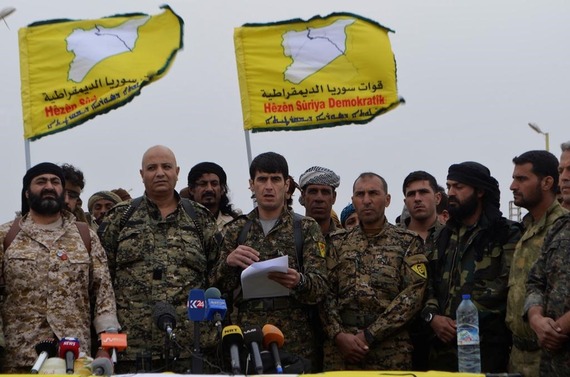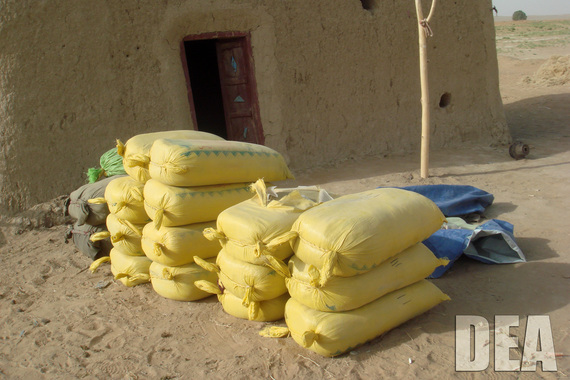Islamic State Caliph Abu Bakr al-Baghdadi
In the pundit frenzy that followed the British referendum on leaving the European Union (EU), a significant anniversary passed by relatively unnoticed. Two years ago, on June 30, 2014, Abu Bakr al-Baghdadi proclaimed the existence of the Islamic State (IS) and declared it to be a worldwide caliphate. This made IS the first caliphate since the formal dissolution of the Ottoman caliphate on March 3, 1924.
Dismissed initially by President Barack Obama as "the JV" team," little more than "al-Qaeda wannabees," IS has proven to be remarkable resilient. It has spread its organization to more than three-dozen countries around the world and has successfully organized or inspired dozens of attacks against Western targets outside of its core area in Iraq and Syria.
At its peak, Islamic State controlled a territory of over 80,000 square miles, albeit most of it desert comprised of a handful of towns and cities and connected by a network of roads. The population of IS was variously estimated at between five million and eight million people. The organization boasted an annual budget of roughly two billion US dollars.
IS has lost considerable ground over the past year, and especially over the last six months. It has relinquished between one quarter and one third of its territory. Its geographic extent, however, is always subject to interpretation since its claim of "control" is a function of the degree to which it can secure the road network.
More significantly, it has been ejected from the principal towns that it held in Anbar province, the Sunni heartland of Iraq, a year ago. Tikrit, Ramadi and now Fallujah have been recaptured by the Baghdad government using a combination of Iraqi Army forces and Shiite militias, supported by both US air power and advisors, and by the Iranian Revolutionary Guards and various militias organized and funded under their supervision.
Its current population is difficult to estimate, but is probably still in the range of at least three million. In the meantime, Iraqi forces, in conjunction with Kurdish Peshmerga units, are slowly advancing on the Islamic State's principal city of Mosul.
In Syria, IS has also steadily lost ground. It has largely lost control of the region along the Syrian-Turkish border, a critical zone essential for its smuggling and resupply operations. Syrian military forces, supported by Russian air power and special forces, have crossed into Raqqa province from the southeast and are within 30 miles of the Islamic State capital in Raqqa.
On the opposite trajectory, Syrian Democratic Forces, a group comprised largely of Kurdish People's Protection Units (YPG) and a combination of Sunni, Assyrian and other ethnic militias currently besieging Manbij, are also advancing on Raqqa, and are roughly equidistant.
Syrian Democratic Forces are currently advancing on the Islamic State capital of Raqqa
As pressure on the Islamic State has mounted it has adopted a dual strategy to avoid defeat in Syria and Iraq. On the one hand, it has generally avoided pitched battles with its opponents, relying instead on a scorched earth policy of inflicting maximum casualties through an extended and prolonged urban warfare campaign.
Relying on the extensive use of improvised explosive devices (IEDs) and the creation of an extensive tunnel network to strike at the rear of advancing forces, it has turned each urban campaign into a prolonged, street-by-street, struggle in urban warfare. In the process destroying much of the cities from which it has been ousted.
At the same time, it has returned to its insurgent roots, organizing bombings against civilian targets in both Syria and Iraq. In the latter case it has targeted Shia communities, in both Baghdad and in the Shiite heartland of Iraq, in a repeat of the terrorist campaigns that marked the first insurgency campaign after the collapse of the Saddam Hussein government in 2003.
In addition, the Islamic State has steadily expanded its ability to carry out terrorist attacks, either directly planned or inspired, throughout Western Europe and the United States. Deadly Islamic State attacks in Paris and Brussels have left scores killed or injured.
It's estimated that IS has at least 200 trained jihadist operatives in Europe, and may have as many as 2,000 jihadists with some weapons and battlefield experiences, that are either European nationals that have returned home or are foreign nationals posing as Syrian refugees. IS itself claims that the number of jihadists it has infiltrated into Europe exceeds 5,000.
In addition, IS militants have been implicated in a range of attacks against soft, tourist oriented, targets in Tunisia and Egypt, as well as Turkey. On June 28, three IS suicide bombers exploded suicide vests at the Ataturk International Airport in Istanbul killing, at last count, 41 people and injuring over 230.
It appears that one of the core strategies of the Islamic State in the Mediterranean region has been to disrupt the tourist industry in North Africa and Turkey. There have not yet been any attacks against tourist targets on the European side of the Mediterranean, but Interpol has already warned that Islamic State is looking for opportunities to stage such attacks.
Solidarity march in Paris following the November terrorist attacks
IS has been heavily engaged in the Libyan Civil War. For most of the year it held control of the Libyan city of Sirte; the only urban center it controlled outside of its core territory in Syria and Iraq. Indeed, there have been indications that IS was considering Libya in general, and Sirte in particular, as fallback locations should they be ousted from Syria and Iraq.
At the moment it appears that it may have lost control over large portions of the city to other jihadist groups that are supporting the Libyan national government. The situation remains fluid.
In the United States, IS has inspired "lone wolf" attacks against "soft' civilian targets, most notably the attacks in San Bernardino on December 2, 2015, and most recently in Orlando on June 12. It is unclear how extensive an organization the Islamic State has been able to create in the United States.
According to the FBI, its agents currently have active investigations on more than 1,000 Americans believed to have ties to the Islamic State. An IS affiliate has been organized in the United States, but it has not formally been recognized by al-Baghdadi as an official franchise of the Islamic State.
Most significantly, however, is mounting evidence that the Islamic State has been expanding its capabilities into criminal activities in Europe. IS has long been involved with the looting and smuggling of antiquities in Syria and Iraq.
The value of the illicit antiquities trade has been variously estimated at between several million and hundreds of millions of dollars a year. The higher number is unrealistic as it is unlikely that the antiquities trade could absorb hundreds of millions of dollars in stolen antiquities.
The likely number is probably in the low tens of millions. It does appear, however, that at least some of the highly publicized destruction of archeological sites at the hands of IS militants may have been purposely staged to provide cover for the looting of antiquities.
IS has also been heavily involved in the smuggling of oil from Syria into Turkey, as well as organizing the transport of illegal immigrants from Libya across the Mediterranean to Europe. Both activities are believed to generate hundreds of millions of dollars in yearly revenues for the organization. More alarmingly there have been recent reports that Islamic State is becoming involved in the smuggling of marijuana from the Balkans into Western Europe.
Such an evolution is not uncommon in terrorist/subversive organizations. European terrorist organizations, like the Baader Meinhof or the Brigate Rosse in the 1970s, often resorted to bank robberies to fund their operations. The FARC (Fuerzas Armadas Revolucionarias de Colombia) in Colombia turned to the cocaine trade.
Taliban hashish seized during Operation Albatross
The Taliban in Afghanistan went from trying to stamp out the cultivation of opium poppies to becoming a major player in the processing and smuggling of heroin. In many cases, the FARC being the most recent, the ideological justification is often set aside as the organization evolves from a political into a criminal one.
Islamic State is in an ideal position to use its capabilities to expand into various for-profit criminal activities. The smuggling networks that are used to bring in fighters and supplies, and are used to smuggle out antiquities, oil or illegal immigrants, can be just as easily be used to smuggle drugs, launder money or traffic in sex workers.
It is likely that, just as with the Taliban, IS will likely expand its portfolio of criminal activities as it evolves from supplying armed muscle to other criminal organizations to actually organizing and directing them.
In short, despite its recent notable setbacks, the Islamic State continues to show that it is resilient and adaptive. The campaign to retake Mosul will stretch out well into 2017. Despite the drives on Raqqa by both the Syrian military and the Syrian Democratic Forces, Raqqa is in no immediate danger of falling, and the campaign to retake Raqqa will be a long, drawn out struggle.
In the meantime, Islamic State will continue to expand its international franchises while increasing both the scale and frequency of its attacks in Europe and North America. It can also be expected to expand its for profit criminal activity as it seeks to replace lost revenues and build up its financial assets.
In short, the "JV team" is, for the foreseeable future, here to stay, and it continues to show that it can handle anything the "pros" can throw at it.




